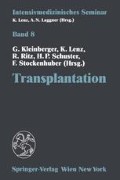Zusammenfassung
Fortschritte auf dem Gebiet des Spender-Managements, der HLA- Typisierung und der Immunsuppression haben die Transplantatüber-lebenszeit entscheidend verbessert [3]. Dennoch gehen noch immer etwa 10 Prozent aller Nierentransplantate im Laufe des ersten Jahres verloren. Als Ursache dafür zeichnen Abstoßungsreaktionen des Empfängerorganismus auf das Fremdorgan wesentlich verantwortlich. Dabei unterscheidet man hyperakute, akzelerierte, akute und chronische Abstoßungstypen. Eine besonders sorgfältige Nachbetreuung des Transplantatempfängers in den kritischen ersten Wochen und Monaten nach Transplantation ist für die Minimierung von Schädigungen des neuen Organs von entscheidender Bedeutung. Hierbei steht die richtige Einschätzung von Risikosituationen, eine adäquate Immunsuppression und Abstoßungsprophylaxe, sowie die rechtzeitige Diagnose und Behandlung von etwaigen Transplantatabstoßungen im Vordergrund.
Access this chapter
Tax calculation will be finalised at checkout
Purchases are for personal use only
Preview
Unable to display preview. Download preview PDF.
Literatur
Kissmeyer-Nielsen F, Olsen S, Posborg-Petersen V, Fjeldborg O (1966) Hyperacute rejection of kidney allografts, associated with preexisting humoral antibodies against donor cells. Lancet ii: 662–665
Lui SF, Sweny P, Scoble JE (1989) Low dose vs. high dose intravenous methyl-prednisolone therapy for acute allograft rejection in patients receiving cyclosporin therapy. Nephrol Dial Transplant 4: 387–389
Neild GN, Rudge CJ (1993) Acute and chronic rejection. In: Thomson AW, Catto GRD (eds) Immunology of renal transplantation. Edward Arnold, London, pp 221–234
Norman DJ (1993) Rationale for OKT3 monoclonal antibody treatment in transplant patients. Transplant Proc 25: 1–3
Rawn JD, Tilney NL (1994) The early course of a patient with a kidney transplant. In: Morris PJ (ed) Kidney transplantation: principles and practice, 4th edn. Saunders, Philadelphia, pp 167–178
Author information
Authors and Affiliations
Editor information
Editors and Affiliations
Rights and permissions
Copyright information
© 1995 Springer-Verlag/Wien
About this chapter
Cite this chapter
Horina, J.H., Horina, G., Holzer, H. (1995). Transplantatabstoßung und Möglichkeiten der Abstoßungstherapie. In: Kleinberger, G., Lenz, K., Ritz, R., Schuster, HP., Stockenhuber, F. (eds) Transplantation. Intensivmedizinisches Seminar, vol 8. Springer, Vienna. https://doi.org/10.1007/978-3-7091-7678-8_20
Download citation
DOI: https://doi.org/10.1007/978-3-7091-7678-8_20
Publisher Name: Springer, Vienna
Print ISBN: 978-3-211-82648-5
Online ISBN: 978-3-7091-7678-8
eBook Packages: Springer Book Archive

